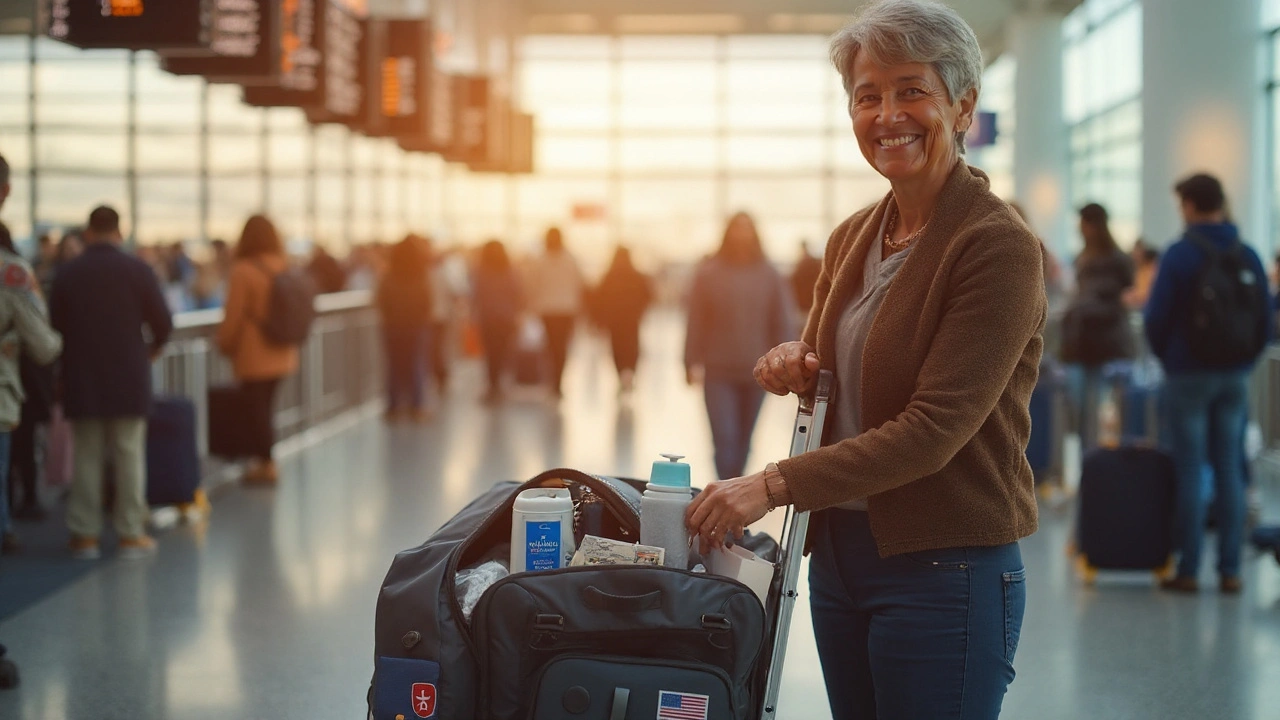
Urinary Retention is a medical condition where the bladder cannot empty completely, often requiring assisted drainage. Whether you’re heading for a weekend getaway or a long‑haul flight, the condition doesn’t have to ruin your plans. Below are proven strategies to keep you comfortable, safe, and in control while on the move.
Know Your Situation Before You Pack
First step: understand the type and severity of your retention. Intermittent Catheter is a thin, flexible tube used to drain the bladder several times a day. If you rely on an intermittent catheter, you’ll need a clean‑room environment and a reliable disposal system. Some people use an External Condom Catheter a adhesive sheath that fits over the penis and diverts urine into a bag. This option can be less invasive for travel but may require careful sizing and skin checks. Identifying which device you use dictates the rest of your checklist.
Essential Packing List
- Catheter kit (intermittent or external) with extra supplies
- Antiseptic wipes and sterile gloves
- Disposable drainage bags (preferably with odor control)
- Portable Portable Toilet compact urinal designed for travel use or a foldable privacy screen
- Medical alert card stating your condition and emergency contact
- Hydration bottle marked with hourly intake goals
- Copy of your latest bladder scan or doctor’s note (useful for customs)
- Travel‑friendly Travel Insurance policy covering medical emergencies related to urinary issues
Keep the most critical items in a carry‑on bag. If you’re flying, place the catheter kit in a clear, resealable pouch so security can inspect without contaminating supplies.
Managing Hydration Without Overloading the Bladder
Staying hydrated is vital, yet drinking too much at once can heighten urgency. Create a Hydration Plan a schedule that spreads fluid intake evenly throughout the day. For a typical adult, 2‑3 liters over 12 hours works well, but adjust according to temperature and activity level. Use a marked bottle (e.g., 250ml increments) and set a timer on your phone. Sip small amounts every 30 minutes rather than gulping large volumes.
Bladder Training Techniques on the Road
Even if you use catheters, strengthening bladder control can reduce the frequency of drainage. Bladder Training a regimen of timed voids and pelvic floor exercises helps. While traveling, set reminders for scheduled catheterizations (e.g., every 4‑6 hours) and practice Kegel exercises in seated positions-no special equipment needed. Document your timings in a small notebook; patterns become clearer and you can anticipate when a restroom break will be necessary.
Choosing the Right Restroom Options
Public restrooms vary greatly. Here are three practical tiers:
- Airport lounges or VIP lounges: usually cleaner, with space for a portable toilet if needed.
- Family‑friendly restaurants: often have larger stalls and baby changing stations you can repurpose.
- Train or coach stations: locate the nearest accessible facility on the station map before you arrive.
When you spot an ideal spot, claim a stall early and use a privacy screen if you need extra cover. Don’t be shy about asking staff for a discreet, accessible restroom; most are accustomed to travelers with medical needs.

Dealing with Emergencies
Even the best plan can hit a snag. Keep these quick‑action steps handy:
- Identify the nearest medical facility: Use a mapping app set to “hospital” or “urgent care” before departure.
- Contact your travel insurance provider immediately; have the policy number on the alert card.
- Use your medical alert card to explain the situation without lengthy descriptions.
- Carry a spare catheter set in a separate bag in case the first kit is damaged.
Having a clear, concise script ready-e.g., “I have urinary retention and need assistance with catheterization”-can speed up assistance.
Comparing Catheter Options for Travel
| Attribute | Intermittent Catheter | External Condom Catheter |
|---|---|---|
| Invasiveness | Urethral insertion each use | Non‑invasive sheath |
| Setup Time | 30‑60seconds | 15‑30seconds |
| Risk of Infection | Higher (requires sterility) | Lower |
| Discretion | Medium (visible tube) | High (hidden under clothing) |
| Suitable Activities | Short trips, bathroom access | Long flights, outdoor events |
Choose the device that aligns with your itinerary. For a cross‑country train ride with limited restroom stops, an external condom catheter may offer the smoothest experience. For short‑haul flights where you can schedule bathroom breaks, intermittent catheters give more control over bladder emptying.
Mindset and Social Comfort
Travel can feel stressful even without a medical condition. A few mental tricks help:
- Reframe the narrative: Think of your supplies as travel accessories, like a charger or travel pillow.
- Practice a brief explanation ahead of time so you sound confident if asked for assistance.
- Connect with fellow travelers who have similar needs via online forums; shared experiences reduce anxiety.
Remember, most people are supportive when you’re clear and polite about your needs.
Post‑Travel Follow‑Up
After you land, schedule a quick check‑in with your urologist or primary care provider, especially if you experienced any pain, unusual urine color, or signs of infection (fever, burning). Document any issues in a travel health journal; this data helps your clinician adjust treatment plans for future trips.
Quick Reference Checklist
- Confirm catheter type and pack extra sets
- Carry medical alert card and doctor’s note
- Secure travel insurance covering urinary emergencies
- Plan hydration schedule and bring a marked water bottle
- Identify accessible restrooms along your route
- Know the nearest hospital or urgent‑care centre
- Practice a concise explanation of your needs
- Schedule post‑trip medical follow‑up

Frequently Asked Questions
Can I bring catheters in my hand luggage?
Yes. Place the catheters, sterile wipes, and drainage bags in a clear resealable bag. Tell the security officer you have a medical device; they’ll usually allow it without additional inspection.
What if I develop a urinary tract infection while traveling?
Seek medical care immediately. Use your travel insurance card to locate the nearest clinic, and bring a urine sample if possible. Start the prescribed antibiotics as soon as a doctor confirms the infection.
Is a portable toilet allowed on airplanes?
Yes. A compact urinal that fits under the seat is considered a medical aid. Inform the airline in advance via their special assistance service; they’ll note it on your reservation.
How much extra fluid should I drink before a long flight?
Aim for about 500ml in the two hours before boarding, then sip 150‑200ml every 30‑45minutes. This keeps you hydrated without overloading the bladder.
Do I need a prescription to travel with a catheter?
A doctor’s note confirming the medical necessity is recommended, especially for customs or airline documentation. It also helps with insurance claims.

19 Comments
Wow, I’ve actually tried the portable toilet trick on a cross‑country train and it felt like having a personal restroom on wheels – absolute game‑changer!
Just make sure the bag is sealed and you have a discreet screen, and you’ll glide through the journey without a hitch.
When you pack your catheter kit, consider using a small zip‑lock bag labeled “medical supplies” and keep a copy of your doctor’s note in a separate envelope – this speeds up security checks and avoids any awkward moments.
Don’t forget to download the airline’s special assistance form ahead of time; filling it out online guarantees they’ll have your catheter paperwork ready, so you won’t be scrambling at the gate.
It is vital to schedule restroom breaks at regular intervals during long flights; setting an alarm every 4‑5 hours helps maintain a stable bladder volume and reduces the risk of over‑distension 😊.
Honestly, many travelers skip the extra drainage bag and then panic when the primary one leaks – a spare is non‑negotiable, especially if you’re on a multi‑day trek where restroom access is limited.
Integrating a pre‑flight checklist that includes “catheter sterility verification, bag integrity test, and alert card accessibility” optimizes procedural compliance and minimizes iatrogenic complications.
One of the most effective strategies for managing urinary retention on extended trips is to adopt a comprehensive hydration‑timing protocol that aligns with your catheterization schedule. First, calculate your baseline fluid requirement based on weight and activity level, then partition the total volume into equal portions throughout the day. Carry a marked water bottle with 250 ml graduations and set a recurring alarm on your phone to remind you to sip every 30 minutes. This prevents large boluses that can overwhelm the bladder and cause uncomfortable urgency. Second, synchronize your catheter changes with these hydration intervals – for instance, if you plan to drain every five hours, schedule a sip‑break fifteen minutes before and after the procedure to stabilize bladder pressure. Third, keep a concise log in a pocket‑sized notebook detailing the time, volume ingested, and catheterization events; patterns will emerge that allow you to anticipate peaks in urine production. Fourth, choose clothing that offers easy access to your kit, such as zip‑front pants, to reduce the time spent maneuvering in public restrooms. Fifth, always carry a secondary set of sterile gloves and wipes in a separate compartment; contamination can be a silent source of infection on lengthy journeys. Sixth, consider using an external condom catheter for flights longer than eight hours because it minimizes insertion frequency and reduces infection risk. Seventh, when traveling by train, scout the station map in advance and mark the location of accessible facilities, so you are not caught off‑guard. Eighth, if possible, arrange for a private lounge access where you can unfold a portable urinal discreetly. Ninth, stay vigilant for signs of urinary tract infection – any fever, burning sensation, or cloudy urine warrants immediate medical attention. Tenth, after each trip, schedule a follow‑up appointment with your urologist to review any issues that arose and adjust your plan accordingly. By integrating these steps into a cohesive routine, you convert a potentially stressful situation into a manageable component of your travel itinerary.
Remember, “its” and “it’s” are not interchangeable – the former denotes possession, the latter a contraction of “it is”, which is crucial when filling out your medical alert card.
Make sure you double‑check that all your catheters are within their expiration dates!!! A quick glance before you zip up your bag can save you a lot of trouble later!!!
Sure, because airlines love extra luggage.
Traveling with a catheter can feel like carrying a secret super‑power – you just have to learn the art of invisibility.
Some say the airline’s “special assistance” program is just a cover for secret monitoring of medical devices – stay alert, keep your kit hidden, and trust no one.
From a biopsychosocial perspective, the act of negotiating bathroom access abroad becomes a microcosm of autonomy versus systemic constraints, highlighting how bodily sovereignty is negotiated within the architecture of modern mobility.
It is imperative that any traveler from our great nation be fully prepared; neglecting proper catheter logistics reflects poorly on our national reputation for excellence.
I totally get how overwhelming it can feel when you think about packing all the medical gear, but think of it as an adventure checklist – each item is a checkpoint that brings you closer to a stress‑free journey. Start by laying everything out on a table: catheters, drainage bags, wipes, gloves, the alert card, and a copy of your prescription. Then group them into “must‑have” and “nice‑to‑have” piles, placing the must‑haves in an easily reachable compartment of your carry‑on. Next, practice a quick demonstration at home so you know exactly how long each step takes; this rehearsal builds confidence and reduces panic in public restrooms. Also, don’t underestimate the power of a friendly smile when asking staff for a discreet location – people respond positively to a calm demeanor. Lastly, after you return, take a few minutes to reflect on what went well and what could be improved; this feedback loop sharpens your future travel plans and turns each trip into a learning experience.
The article is adequate, though it could benefit from a more detailed discussion of infection control protocols.
Yo, pack that kit like a boss – you’ll thank yourself when you’re chillin’ in the airport and not scrambling for a spare catheter.
Super helpful guide! 👍🏼✈️🧳
While it’s crucial to stay prepared, remember that excessive worry can turn a smooth trip into a nightmare – keep the balance and trust the process.